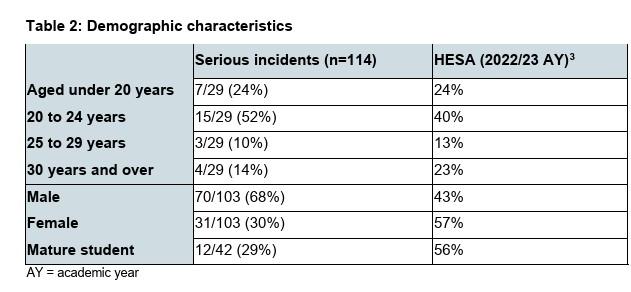Mark Brooks (27 May 2025)
Why gender-sensitive research and policymaking is vital: Male student suicide deaths
Last week, the Department for Education (DfE) published its National review of higher education student suicide deaths. It makes for chilling and worrying reading. Far too many men and women are losing their lives.
The report states that the DfE were informed of 107 suspected suicide deaths and 62 incidents of non-fatal self-harm in higher education students during the 2023 to 2024 academic year. In response, they received 104 detailed serious incident reports from higher education providers – 79 of which were suicides and 25 were reports into serious self-harm.
- The breakdown of the 79 suicides show that men accounted for around three-quarters (52, 71%)*.
- The overall figures for serious incident reports (suspected suicides plus non-fatal self-harm) show men make up 68%. The table below (source: Department for Education) highlights the number and percentage of serious incidents and the overall student population. It shows male students are over-represented.

The report highlights two broader inter-linked issues about how statistics and narratives cover issues on gender, including where men and boys are disproportionately affected.
(1) The first mention in the statistics highlighting the full gender breakdown of affected students does not appear until page 22 of the report (the bullet points above).
There is a section at the start of the report (page 7) that highlights overall student characteristic data. Yet, this section does not mention the macro-level gender characteristics. It should.
The report does state right at the beginning that “Suicide is the leading cause of death in adolescents and young adults and suicide rates have increased over the last decade, particularly in women and girls under 25”. However there is no acknowledgement of the asymmetric nature of the data that allows this statement to be made. Overall, the suicide rate for young men in all settings is 71% of the total.
The truth is that men in higher education are killing themselves by suicide at more than twice the rate of young women. If the ratios were reversed would those reporting the data not highlight this fact in the beginning and throughout? The fact the gender differential in the data is not seen as worthy of much comment is an interesting finding worth thoroughly testing.
(2) The second point is that throughout the report there is important data – from the method of death, patterns of engagement and the actual background problems these students face.
But because there is little in the way of analysis by gender, it is hard to gauge, and therefore understand, whether gender had a part to play in any of the above. A gender breakdown would show patterns and trends – which then:
- helps broader public understanding (as gender was not highlighted overall, it did not feature in media coverage on the BBC);
- potentially improves the support and response by universities to men and women in distress because they better understand any gender dimensions;
- improves the report’s recommendations, because again, they would take into account any gender dimensions. They do not reference gender.
Conclusion and Recommendation
Overall, as set out in our Missing Men Report, it is vital that a gender-sensitive lens is applied to research and public policymaking. If this had been applied here, it would have improved on what is already a really important and valuable piece of research.
More widely, it is important to gain a better understanding of the editorial thought process around gender. To see whether (and then why) there is a difference in how gender is editorialised when men and boys are disproportionately affected by an issue.
Notes
* The suicide rate produced by the Office for National Statistics is calculated on suicide deaths per 100,000. Due to fewer men (43%) studying in higher education (1.67 million females and 1.25 million males in 2022/23, according to the Higher Education Statistics Agency), the proportion of male student suicides is likely to be at national levels of 74-75%.
52 of 79 is a lower figure but in 10% of the serious incident reports they received, gender was not included so it is reasonable to assume that in this study the male suicide rate is at or around national level.